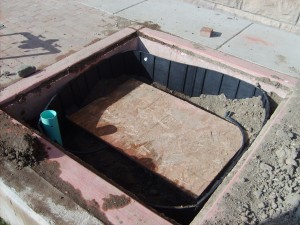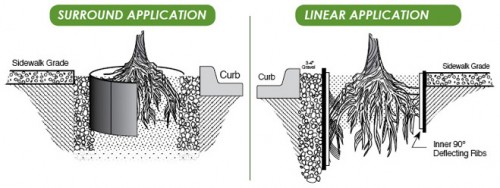In an urban environment, street trees are considered a necessity, but sometimes a nuisance. There are a series of considerations that should be made when incorporating street trees into the urban framework.

Root Barrier: What is the most common nuisance in our historic neighborhoods in regards to trees? Most people would say that it is with the cracks in sidewalks that are caused by the street trees. In fact, this is a very common problem that has led some municipalities to forbid street trees between the sidewalk and the curb. Everyone knows that street trees provide great shade and ecology to our urban districts and neighborhoods. There is no denying the great relief and enclosure that shade trees provide and the added habitat for birds, etc. The problem is, how do we provide this without jeopardizing our sidewalks? One solution is to utilize trees that have a deeper root system so the roots will not encroach into the sidewalk in time. This can be a difficult task, especially if your landscape architect is not experienced with working with street trees. Another solution is a root barrier.
I like to utilize both proper tree selection and root barriers when designing an urban landscape. Tree selection a crucial aspect, but just in case, I also like to use a root barrier. A commercial root barrier that I recommend is from Century Root Barrier (Century). The panels for the root barrier have an interlocking feature included which eliminate the need for gluing the panels together. You can choose from a variety of products, some that can form right angles for square/rectangular grates and some that are more circular. Both applications have their place. Where there is area to spare, I recommend the circular, continuous panel to limit the risk of joints or openings for the roots to penetrate. The right-angled panels are great to maximize the space available for the rooting of the trees, which can be crucial.
The root barriers are not only good for minimizing the future issues with the sidewalks, but they also assist in keeping the soil for the tree in a non-compacted state. Compaction around the tree can suffocate the tree if proper steps are not taken to minimize the compaction.









7 thoughts on “Urban Street Trees: Root Barrier”
Pingback: Urban Tree Selection | Architecture, Engineering & Planning EVstudio | Denver & Evergreen Architect | Colorado & Central Texas | Blog
Marian, I’m curious what municipalities adopt regulations against street trees? I’ve certainly seen neighborhoods without them, but its something of a barren landscape unless all your trees are very large and mature. Trees can cause problems, but again I think its about species selection. I’m a fan of street trees.
You do bring up an interesting point about the arborists who value the trees over the structures. I haven’t actually encountered this but I wouldn’t be surprised. Again, any specific places?
I have a tree/sidewalk conflict waiting to happen at my house. At some point the tree will start moving the sidewalk and that will be the end of the tree. I’ve planted a replacement in a better spot so that we can enjoy the larger one until it causes an issue and hopefully the smaller one will have some time to develop first.
thanks for participating, Sean
Some certified arborists are more like certified imbeciles where street trees are concerned. Some of them see a tree and think “keep it, and the driveway, sidewalk, and surrounding structures be damned.” Root barriers may help with soil coimpaction, but if the tree is too large for the space where it is planted or if it is a “nuisance tree” such as a silver maple or box elder, barriers will not be of lasting benefit. I would favor regulations adopted by some cities of no trees between the sidewalk and the street and no trees within 10 feet of a driveway.
Another fact that has to be recognized by these root barriers is that the limiting of root spreading will also hinder the trees ability to withstand heavy wind. Places that incur heavy wind damage need trees that have a wide and deep root base otherwise the percentage of uprooting the trees will increase dramatically. Yes dangerous sidewalks are a much more common occurrence than trees being uprooted and causing damage, but it is still something to consider in places that have homes/buildings near the road and the trees that line them.
Thank you for your comments L Ellis and Sean. There are indeed multiple options for protecting the sidewalks and the options that you have listed are fantastic choices. Unfortunately, cost is always an issue with clients. The root barrier is a cost-effective mechanism for the lifetime of our sidewalks. I spoke to a former client in Pueblo who actually reused large pieces of thick grade plastic to accomplish the same thing for his personal sidewalk, virtually for free.
One option, which is preferable, is to utilize the root barrier for a much longer span, rather than only the size of the tree grate. In doing this, the tree roots are allowed to grow a much greater distance parallel to the sidewalk. At the surface, this could be accomplished with groundcover, other plant material or even porous pavers of some sort (as long as compaction is minimized). Unfortunately where we need trees the most, in a more urban setting, (such as T-4 to T-6 on the urban-to-rural transect, if you are familiar with that) space is limited.
In regards to tree selection, I have spoken with ordinary people without any credentials or titles that are absolutely brilliant in plant selection. On the same token, I have also spoken with landscape architects/ designers and arborists who are ignorant about plant selection. As Sean pointed out, it is about the species and what is appropriate where. Thank you both again for your input.
I think it largely comes down to species selection. Whether your tree selections are by a landscape architect or an arborist you need someone who knows the species well. Sometimes the root barrier is correct and sometimes you have to look at other possibilities. In design of urban spaces you’re faced with a variety of challenges and you need a full range of options.
If you want good information on trees, talk with a Consulting Arborist, not a Landscape Architect. All of the research on root barrier shows that at best, it buys you time as roots will grow under the barrier and and new roots will then take advantage of good air and perhaps better drainage conditions and be back at the surface. Worse case is that the root barrier will girdle and kill the tree.
There is no substitute for an appropriate fit of Right Tree, Right Place, giving street trees plenty of room, and designing tree pits that accomodate growth. Invest in sufficient space for the tree upfront through using either Silva Cells (http://www.deeproot.com) or a concrete vault if space is really tight and yet street trees are desired. Another strategy that should be used in combination with ample soil and rooting area is to utilize a modular paving such as Terre Walks or interlocking concrete pavers. A really good reference is James Urban’s Up By Roots. (http://secure.isa-arbor.com/webstore/Up-By-Roots-P353C49.aspx)
Designs for street trees should be as thoroughly considered and sustainable as some of the creative high level thought that goes into designing green buildings.
Comments are closed.